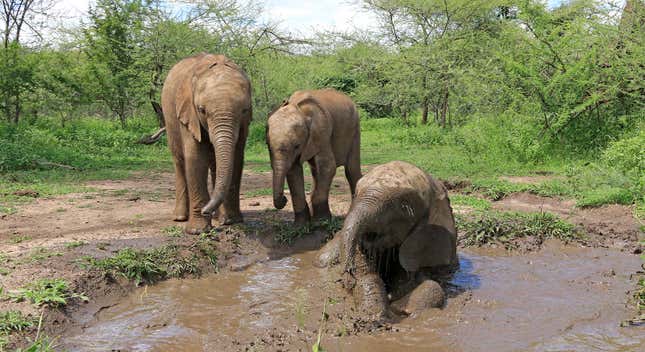
Over 350 elephants have died in Botswana since March, sparking a government probe to investigate the mysterious deaths.
Warning: This post contains graphic images of dead elephants.
The grassy Okavango Delta of Botswana has been a sad sight these days, with hundreds of elephant carcasses strewn across the region. Over the past four months, of 356 reports, 275 elephant carcasses have been confirmed near the village of Seronga, according to a statement issued yesterday by Botswana’s Ministry of Environment, Natural Resources, Conservation and Tourism.
The “ongoing investigations into the deaths of the elephants have revealed no evidence of poaching so far,” the ministry said. Indeed, the deaths are presenting somewhat of a mystery as the carcasses appear to be undisturbed, including untouched ivory tusks.
Samples of the dead elephants are being sent to laboratories in Zimbabwe, South Africa, and Canada. Results from these labs will be compared to field evaluations made by veterinarians, according to the ministry. Botswana officials are eager to know if the elephants died from natural causes, such as disease, starvation, or thirst, or from unnatural causes, such as deliberate poisoning.
The elephants are being killed by disgruntled farmers is not out of the question, as elephants are known to destroy crops. It is not uncommon for elephants in Africa to be deliberately killed with cyanide. In 2013, for example, this toxin was used to kill over 300 elephants in Zimbabwe. That said, the cause of death in these most recent cases remains unclear, at least for now. Anthrax, which was initially considered to be a likely cause, has been ruled out as a possibility, and it’s unclear if cyanide is involved, as the remains of scavenging animals have not been found near the elephant carcasses, reports the Guardian.
Elephants Without Borders (EWB), a local conservation group, recently performed helicopter surveys of the Okavango region.
“Several live elephants that we observed appeared to be weak, lethargic and emaciated,” according to EWB’s ensuing 97-page report. “Some elephants appeared disorientated, had difficulty walking, showed signs of partial paralysis or a limp. One elephant was observed walking in circles, unable to change direction although being encouraged by other herd members.”
Elephants of all ages and sexes appear to be dying, and many carcasses were found near natural waterholes and along trails. As EWB notes, many elephants died “in a sternal position on their chests, suggesting a fast and sudden death.”
So it appears the elephants fell onto their faces as they died. A frightening possibility is that elephant populations in Botswana are being killed by a yet-to-be identified disease, possibly something that’s attacking their neurological system, as Niall McCann, a conservationist at National Park Charity, told the BBC.
Conservationists have removed the tusks from the dead elephants to prevent opportunistic poachers from snatching the contraband items. They’re also disposing of carcasses located near populated settlements, according to the ministry’s statement.
Botswana hosts the largest elephant population in Africa. The country’s elephant population has rebounded since the 1990s, with surveys suggesting numbers now close to 130,000 individuals. In the late 1990s, this number was closer to 80,000.
For now, we’ll have to be patient and wait for the results of the investigation to come in, but these are definitely strange circumstances. Should a disease be implicated in these deaths, that would be a very 2020 finding given this remarkably godawful year.